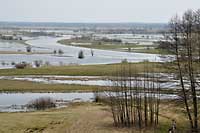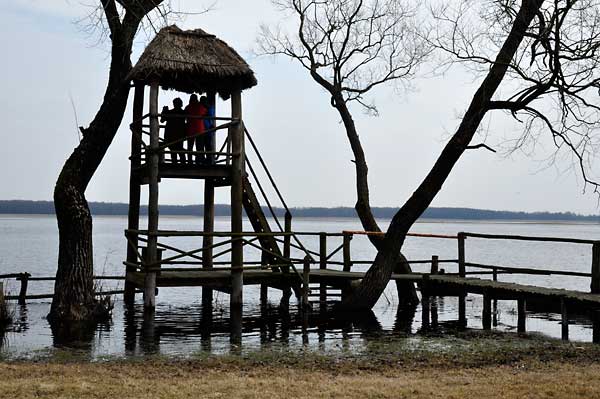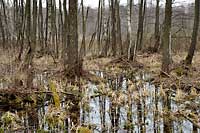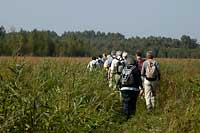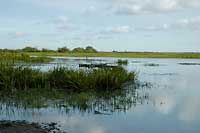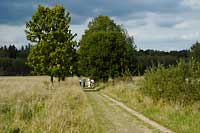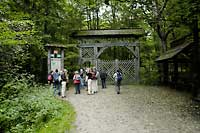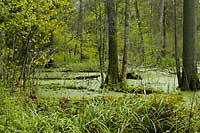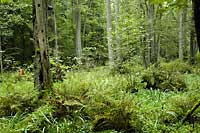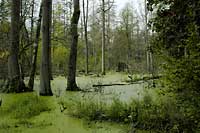EXPLORING THE BIEBRZA VALLEY MARSHES
AND BIALOWIEZA FOREST

This ornithological route traverses both the Bialowieza Forest and the Biebrza Valley marshes which are real, unspoilt wildlife sanctuaries, and the most frequent tours of birdwatchers in Poland. Between them lies the lesser known but equally interesting marshy valley of the Narew river, designated as a National Park as recently as 1996. The route is 600 kilometres long.
ITINERARY
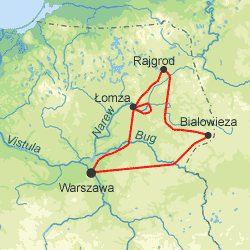
DAY ONE
Arrive in Warsaw and transfer by coach to Lomza [150 km]. If time allows we will stop en route to visit meadows in the Bug river valley between Wyszkow and Brok. Here the river meanders through the countryside and has created numerous branches and old beds. The whole valley supports over 100 species of birds. Nesting birds include: Little Bittern Ixobrychus minutus, Black Stork Ciconia nigra, White Stork C. ciconia , Honey Buzzard Pernis apivorus, Marsh Harrier Circus aeruginosus, Lesser Spotted Eagle Aquila pomarina, Corncrake Crex crex, Little Ringed Plover Charadrius dubius, Great Snipe Gallinago media, Black-tailed Godwit Limosa limosa, Curlew Numenius arquata, Redshank Tringa totanus, Kingfisher Alcedo atthis and Bluethroat Luscinia svecica. Overnight stay in Lomza.
DAY TWO
A morning's birdwatching in the Narew river valley close to Lomza. Here the river flows through a relatively narrow and deep valley and each year the river bursts its banks during spells of wet weather.
There is a rich and differentiated flora with xerothermic communities on the banks.
125 species of birds nest here, amongst them are: Bittern Botaurus stellaris, Marsh harrier Circus aeruginosus, Lesser Spotted Eagle Aquila pomarina, Water Rail Rallus aquaticus, Spotted Crake Porzana porzana, Corncrake Crex crex, Common Snipe Gallinago gallinago, Crane Grus grus, Great Snipe Gallinago media, Woodcock Scolopax rusticola, Black-tailed Godwit Limosa limosa, Aquatic Warbler Acrocephalus paludicola, Penduline Tit Remiz pendulinus, and Common Rosefinch Carpodacus erythrinus
Later we transfer to the edge of the southern basin of Biebrza, where the Biebrza river flows into the Narew. Return to Lomza.
DAY THREE
A full day visit to the southern basin of Biebrza. The choice of route will be determined by the current accessibility of the area. The southern basin is about 30 km long and up to 10 km wide, a swampy area which is uninhabited and largely uncultivated, and is a part of the Biebrza National Park.
165 species of birds have been recorded here and thousands of birds stop during spring and autumn passage. The Biebrza valley is also a home for big mammals such as Elk and Wolf.
In the evening we transfer to a small riverside town, Goniadz [30 km] or to Rajgrod [50 km] for an overnight stay.
DAY FOUR
After a morning's birdwatching we will explore the marshes of the central basin of Biebrza either on foot or by boat. The nature of this area is more differentiated than in the southern part, but not so wild. The landscape is enriched by sandy mounds and patches of forest spread amongst the wet meadows and marshes.
About 170 species of birds nest here, amongst them are: Bittern Botaurus stellaris, Black Stork Ciconia nigra, White Stork Ciconia ciconia, Honey Buzzard Pernis apivorus, White-tailed Eagle Haliaetus albicilla, Short-toed Eagle Circaetus gallicus, three species of Harrier, Lesser Spotted Eagle Aquila pomarina, Spotted Eagle Aquila clanga, Black Grouse Tetrao tetrix, Spotted Crake Porzana porzana, Little Crake Porzana parva, Corncrake Crex crex, Crane Grus grus, Ruff Philomachus pugnax, Great Snipe Gallinago media, Curlew Numenius arquata, Black-tailed Godwit Limosa limosa, Eagle Owl Bubo bubo, Short-eared Owl Asio flammeus, Grey-headed Woodpecker Picus canus, White-backed Woodpecker Dendrocopos leucotos, Bluethroat Luscinia svecica, Grasshopper Warbler Locustella naevia, Aquatic Warbler Acrocephalus paludicola and Red-breasted Flyctcher Ficedula parva. Overnight at the same place.
DAY FIVE
Transfer to Bialowieza [150 km]. On our way we will stop to visit the Narwianski National Park. Here the Narew river flows through wet and periodically flooded meadows. Its numerous branches and old river-beds create a real labyrinth - a perfect area for canoeing.
After drainage works in this area a few years ago the populations of many bird species declined, but it remains an attractive area for birdwatchers. About 160 species of birds nest here including: Bittern Botaurus stellaris, Garganey Anas querguedula, Shoveler A. clypeata, three species of Harrier, Water Rail Rallus aquaticus, Little Crake Porzana parva, Corncrake Crex crex, Crane Grus grus, Woodcock Scolopax rusticola, Black-tailed Godwit Limosa limosa, Kingfisher Alcedo atthis, Bluethroat Luscinia svecica, Savi's Warbler Locustella luscinioides, Aquatic Warbler Acrocephalus paludicola, and Sedge Warbler Acrocephalus schoenobaenus.
Overnight stay in Bialowieza.
DAY SIX
A full day walk through the strict reserve of the Bialowieza National Park.
The Bialowieza Forest is famous throughout the world as the place where the European Bison was saved from extinction, as well as containing the last remnants of the great, lowland forest which once clothed much of Europe. Out of the 62000 hectares which make up the Polish part of the Forest, the National Park contains about 10000 hectares and a further 2000 are protected as nature reserves. The Bialowieza National Park was designated as a World Biosphere Reserve and placed on the list of World Heritage Sites.
Though the greater part of the Bialowieza Forest is managed, the forest complex has preserved its natural character and unique biological diversity. About 160 species of breeding birds include: Black Stork Ciconia nigra, Honey Buzzard Pernis apivorus, Short-toed Eagle Circaetus gallicus, Lesser Spotted Eagle Aquila pomarina, Booted Eagle Hieraetus pennatus, Hazelhen Tetrastes bonasia, Black Grouse Tetrao tetrix, Capercaille Tetrao urogallus, Green Sandpiper Tringa ochropus, Eagle Owl Bubo bubo, Pygmy Owl Glaucidium passerinum, Tengmalm's Owl Aegolius funereus; Woodpeckers - Grey-headed W. Picus canus, Black Dryocopus martius, Middle-spotted Dendrocopos medius, White-backed D. leucotos, and Three-toed Picoides tridactylus; Red-breasted Flycatcher Ficedula parva, Collared Flycatcher F. albicollis, Nutcracker Nucifraga caryocatactes, Common Rosefinch Carpodacus erythrinus, Golden Oriole Oriolus oriolus and Bullfinch Pyrrhula pyrrhula.
Overnight stay in Bialowieza.
DAY SEVEN
A walk or bicycle ride through the managed part of the Bialowieza Forest, where there are also many birds and you are more likely to meet big mammals such as Bison, Red Deer, Wolf, Lynx and Wild Boar.
Overnight at the same place.
DAY EIGHT
Transfer to Warsaw and depart for home.
OPTIONAL VISITS
During this tour optional visits can be arranged to the following important historical monuments:- Warsaw - the biggest city and capital of Poland, totally destroyed during the Second World War. The old town, carefully reconstructed after the War, has been recognised as a World Heritage Site
- Treblinka - a former death camp where over 750000 people were killed by the Nazis
- Nowogrod - an open air museum of folk architecture
- Picturesque riverside towns suah as Tykocin and Drohiczyn, places where time seems to stand still
- Orthodox churches









